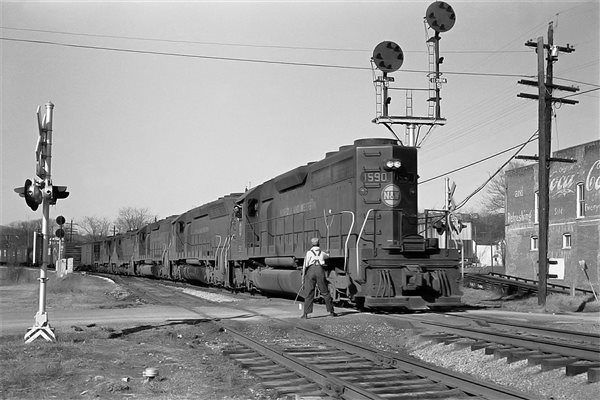
At least from my perspective, there’s lots to like in the photo above, showing Norfolk & Western’s time freight Second 51 about to take orders at Buena Vista, Virginia on March 18, 1968. Yes, that’s the train’s advertised designation, not a reference to a second/added section of a scheduled train. It should also be clear that these are Form 19 orders, not form 31, which would require the train to stop.
“BV”, as it was (and still is) referred to by locals, is on what was then known as the N&W’s Shenandoah Line, built originally from Hagerstown, Maryland to Roanoke, Virginia by the Shenandoah Valley Railway following the Civil War. To put it in a more precise geographic position, milepost 185 (as measured from the northern terminus) is a short distance behind me here.
What’s on view here is rich in railroad tradition. The employee with the “high-speed” order forks (one already raised to hand off the first copy of a train order to the engineer, with the other at ease now, destined for the conductor in the caboose) is dressed in bib overalls; no 1960s attire here!
Interestingly, this line of the railroad was controlled by CTC (Centralized Traffic Control), with trains generally proceeding on signal indication, so train orders were not used routinely; indeed, this is the only instance I recall of this occurring during four school years of train watching. BV still had an agent, but no operator. As I recall, there was some event, likely maintenance, that merited a ‘temporary’ capability of issuing train orders at this location; I’m glad that I got to see it!
The motive power, a mix of first (GP9s) and second-generation diesels, led by SD40 1590, followed by an SD45 and another SD40, are running in classic N&W fashion, with the leader positioned long-hood forward (better collision protection for the crew) and high short hoods. Following in the consist are traditional “high cars” (boxcars, a single tank car, and what looks like a lone reefer right behind the locomotives) bearing the names of long-since deceased railroads, including the N&W.
Located at the right side of the picture are two other items of interest. Little seen in recent years, at this time, places like Buena Vista originated single-car intermodal (piggyback/trailers) loads, and it was possible to see Roanoke-Shenandoah, Virginia locals 102 and 103 dealing with this traffic. Getting the ‘pigs’ on and off flatcars at this location was accomplished by installing an old, relatively short flat car sans trucks with one end on the ground, and the other at the height of the piggyback flat being loaded, a quite economical solution.
On the wall of the building behind this was a painted beverage advertisement. Coca-Cola is still sold virtually “everywhere” in this country, but advertising painted on the side of brick buildings trackside generally ran its course many years ago, although this sign still exists, and has been restored recently.
Still there as of early 2023, although not likely to see 2024, are the CPL (Color Position Light) signals controlling the north end of the siding and the main seen between the lead unit and the “intermodal facility”.
For that matter, even the means used to record the scene now deserve the ‘classic’ description. The camera used to capture the scene couldn’t be used for either incoming or outgoing calls, required no electrons whatsoever, and accordingly, eschewed batteries entirely. The output produced by snapping the shutter was recorded as a “latent image” on a long strip of acetate coated with chemicals that required manual effort to move from one side of the camera to the other so that another photo could be taken. It wasn’t uncommon not to see the resulting image for a long time; weeks, even months, in some cases.
Congruent with the title, though, there is lots of classic material in sight. However, it’s impossible to overlook the fact that ‘classic’ is a relative term. I suspect that someone personally acquainted with the steam-era N&W, including the two employees pictured here, might look at this and wonder what I was talking about…
Photo by George W. Hamlin